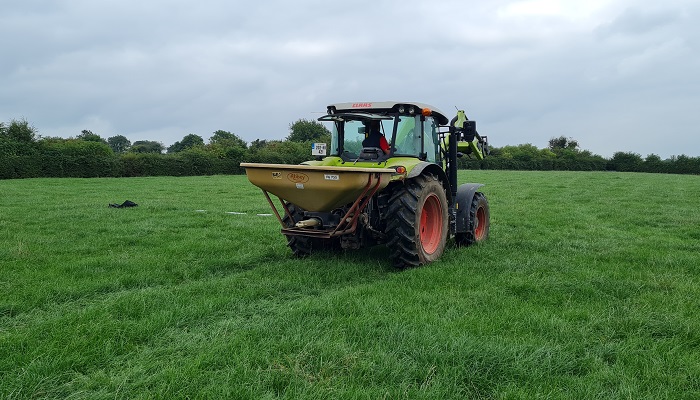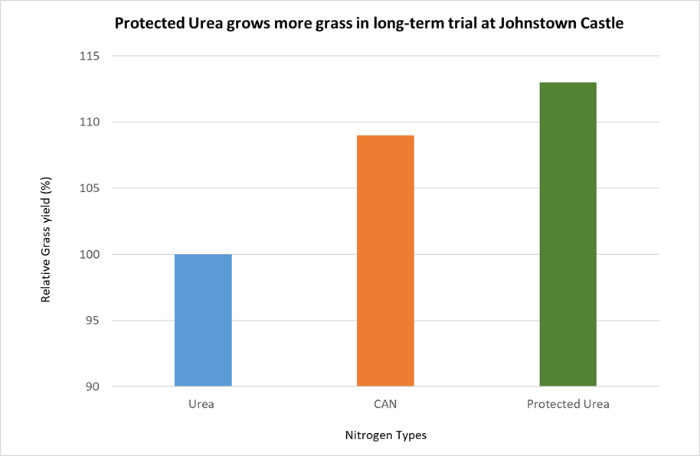05 June 2025
Protecting farm fertiliser nitrogen for farm productivity

Making the switch to protected urea delivers costs savings, more grass from less nitrogen, reduced farm emissions and more, Specialist on the Teagasc Signpost Programme, Mark Plunkett delves into some of the key benefits.
Urea fertiliser is the most widely used nitrogen (N) source in the world and protecting it with a urease inhibitor (NPBT / NPPT) makes it one of the most cost effective and sustainable N sources for grass production.
By replacing nitrate-based fertilisers (e.g. CAN) with protected urea, we reduce N₂O (most powerful greenhouse gas) losses by 71%. Protected urea is a key technology to help agriculture build productivity and profitability now and in the years ahead while delivering a 4 to 8% reduction in verifiable total farm carbon emissions on livestock farms.
Cost savings
Over the last 24 months, fertiliser N prices have come down from the highs of 2022/2023 but still remain relatively expensive. A considerable price differential still remains between protected urea and CAN, with urea significantly better value due to larger volumes traded globally. Fertiliser prices to date in 2025 (table 1) show that protected urea offers a 17% lower cost per kilo compared to CAN (27% N). Putting this cost saving into context, a dairy farmer operating on 50ha and spreading 200kg N/ha can save €2,700 when spreading protected urea versus CAN.
Table 1: Average price of fertiliser nitrogen in 2025
| Protected urea (46%) | CAN (27%) | |
|---|---|---|
| kg N/tonne | 460 | 270 |
| €/tonne | €590 | €420 |
| €/kg | €1.28 | €1.55 |
Retaining more effective N and reducing N rates
Protected urea reduces N (ammonia) loss from 15% for standard urea to 3%, thus retaining 12% more effective N. With reduced and more regulated chemical fertiliser N use, retaining more effective N allows adjustments to N rates while still maintaining grass yields compared to standard urea. Take an example 50ha dairy farm switching from applying 210kg N/ha as all standard urea to protected urea, N rates can be reduced by 12% equating to a reduction of 22kg N/ha giving a fertiliser farm N saving of €1,410.
More grass from less N
A long-term trial at Johnstown Castle is consistently showing that the grass grown by protected urea has been greater than standard urea. Protected urea grew 13% more grass on average compared to standard urea. The additional yield is similar in magnitude to the extra effective N level delivered to the plant by protected urea over standard urea. Protected urea grew 4% more grass than CAN. At a time of more regulated chemical fertiliser N use, moving from standard urea to protected offers the opportunity to reduce fertiliser N rates by up to 13% while delivering a significant reduction in ammonia emissions.
Figure 1: Long-term trial at Johnstown Castle shows that protected urea grows more grass in 7 out of 8 years

Reducing farm emissions
By switching to 100% protected urea on dairy farms, total farm emissions have the potential to be reduced by 7-8% at a spreading rate of up to 200 to 240kg N/ha. The equivalent savings on total emissions on drystock farms are ~4% at a spreading rate of 60 to 80kg N/ha. To achieve a 100% switch to protected urea the use of high phosphorus (P) and potassium (K) products such as 18-6-12 +S would be required to deliver P, K and sulphur.
On-going research at Johnstown Castle is showing that fertiliser blends containing N with a high ratio of ammonium-N to nitrate-N are more stable and environmentally better. For example, the N form in 10-10-20 / 18-6-12 is mainly ammonium-N resulting in a 40% reduction in N₂O emissions relative to CAN 27% N for high Nitrate-N based compounds such as 27-2.5-5 / 24-2.5-10 etc.
Spreading and fertiliser spreader calibration
When it comes to spreading urea, it is important firstly to purchase a good quality product to ensure good spreadability and evenness of application. Secondly, check the fertiliser spreader app to get correct fertiliser spreader settings for an even and accurate spread.
In Summary, making the switch to protected urea delivers the following:
- Reduce your fertiliser N costs by 17%
- Grow 13% more grass with protected urea
- Protected urea is the most sustainable N source for grassland systems
- Reduce verifiable total farm carbon emissions by 4 to 8%
- 18-6-12 most cost effective N-P-K-S source
- Purchase a good quality fertiliser for good spreadability.
For further insights and more information, visit the Signpost Programme webpage here.
